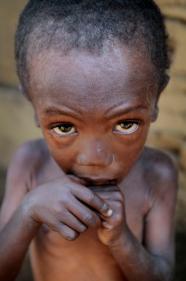| @wehaitians.com | |
No one writes to the tyrants | |
HistoryHeads/Not Just Fade Away |
| Correspond with us, including our executive editor, professor Yves A. Isidor, via electronic mail: |
| letters@wehaitians.com; by way of a telephone: 617-852-7672. |
| Want to send this page or a link to a friend? Click on mail at the top of this window. |
|
 |
|
| A SPECIAL SECTION: Haiti, Since the January 12, 2010 Fierce Earthquake |
| _________________________ |
Posted , May 25, 2011
FURCY, Haiti (AP) — Where the road gave way to trails, the hunger-hunters parked their motorcycle and hiked for more than an hour up a mountain too steep even for mules. There, in a foggy clearing high above the Haitian capital, the Baptist aid workers made their find.
 |
| MORE IMAGES: The faces of hunger |
Two glassy-eyed boys stood beside a wood and mud hut. Their low weight made them look half their ages, but their hair, grey and patchy from lack of nutrition, gave them the appearance of old men.
"They looked as though they were ready to die," said Hilaire Etienne, one of the aid workers. "They were merely bones and just skin on their bodies."
Haiti has long struggled with malnutrition as a result of widespread poverty, a dearth of jobs and a feeble agricultural sector. UNICEF says malnutrition is responsible for about 60 percent of all deaths in people under 18 in the country. An estimated 30 percent of Haitian children are chronically malnourished, their growth often stunted.
Health workers believe there are thousands of children like Jameson and David Paul, the starving brothers discovered in Furcy, who are slowly suffering out of sight of the massive humanitarian effort in the capital just 30 miles away.
There's a little more hope for the Paul brothers now, due to the efforts of the Baptist Haiti Mission, which tracks down hungry children in remote areas of the country and feeds them. Etienne and his partner, Michel Raphael, earn about $75 a month trekking into the mountains and banana groves of Haiti with supplies of vitamins and vaccines and a portable scale to weigh children.
In the Haitian countryside, children are seven times more likely to be malnourished than their counterparts in densely populated Port-au-Prince and other cities, said Mohamed Ayoya, UNICEF's chief of nutrition in Haiti. Such remote areas can be difficult to reach because many roads are damaged or dwellings are accessible only by foot, making food delivery a challenge.
The 68-year-old Baptist Haiti Mission is one of Haiti's oldest charities, but it isn't alone in trying to reach poor people deep in the countryside. The U.S.-based Partners in Health has been working in the country's remote areas for years, as has UNICEF, which plans to send workers with the Haitian government later this month to the Grande Anse area, in the country's far west, to investigate a reported spike in malnutrition.
Hunger also is an issue high on the agenda of newly elected President Michel Martelly, who has pledged to revitalize the country's farming sector, devastated by the effects of cheap food imports and deforestation. Much of the country's foliage has been destroyed by Haitians chopping down trees to make charcoal.
Raphael said he welcomes the aid that has come to Haiti since the 2010 earthquake leveled the capital, but laments that he doesn't see much of it in the mountains.
"When I think about how much money comes into the country, I realize that nothing ever comes to the peasants in my area," said Raphael, 35, who followed in his father's footsteps by becoming a health care worker.
On the morning Raphael and Etienne found the Paul brothers, they had left the Baptist Haiti Mission at sunrise, wearing jackets against the chilly air and carrying chewable vaccinations for typhoid and tetanus. They brought their scale with them on house calls, and the villagers referred to them as "doctors," even though they aren't.
The pair urged parents to bring their children to be weighed, but a few of the more agile tots scampered behind banana trees, fearful of vaccinations.
The health workers nabbed one preschooler who squealed as Etienne hung him by his T-shirt from a hook at the end of a scale. He weighed about 20 pounds, far lighter than a normal child his age.
An hour later, the aid workers found the Paul brothers — 6-year-old Jameson and David, 4. The brothers had the gray hair of village elders, and were being raised by their grandmother after their mother dropped them off and left.
Etienne and Raphael gave them vitamins and potatoes that they had grown from their own gardens.
"When I look at these kids and look at mine, it really hurts," said Raphael, a married father of two girls and a boy.
The Pauls' grandmother, Sentina Estime, said they suffer from constant itching — a sign of malnutrition — as well as hunger.
"They itch all the time," Estime said. "They need to go to see a doctor, but I can't bring them because I'm not in good health myself."
Yes, Etienne and Raphael, agreed, they need to see a doctor. Meanwhile, the aid workers promised to return in a couple of weeks with more vitamins and potatoes.
"We do what we can do," Etienne said. Malnutrition brings many complications.
He packed his scale and vitamins and set off to look for more hungry children.
Copyright © 2011 The Associated Press
| Wehaitians.com, the scholarly journal of democracy and human rights |
| More from wehaitians.com |